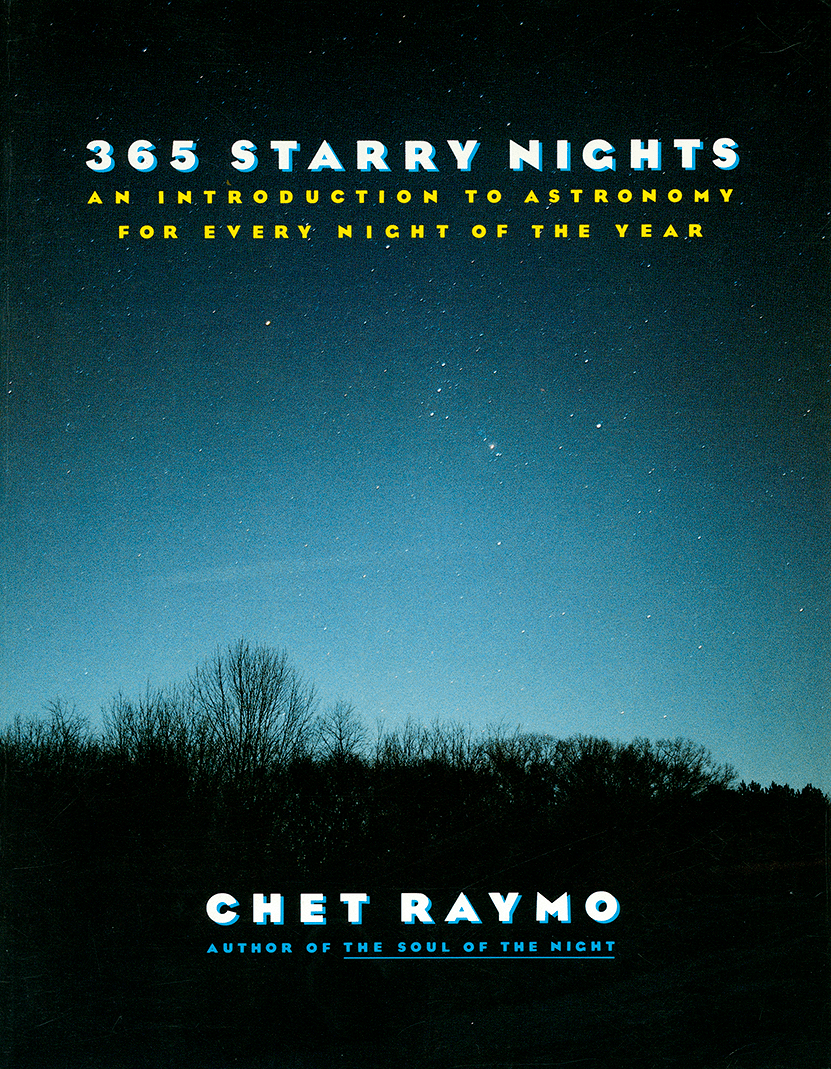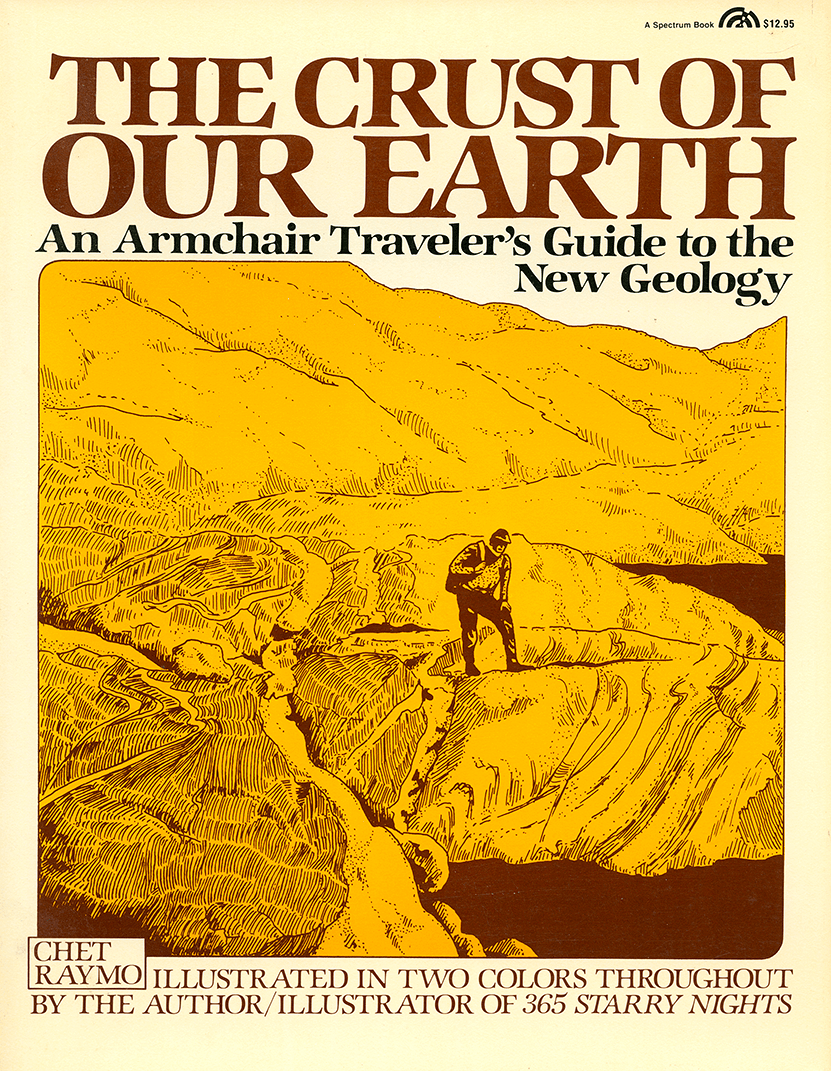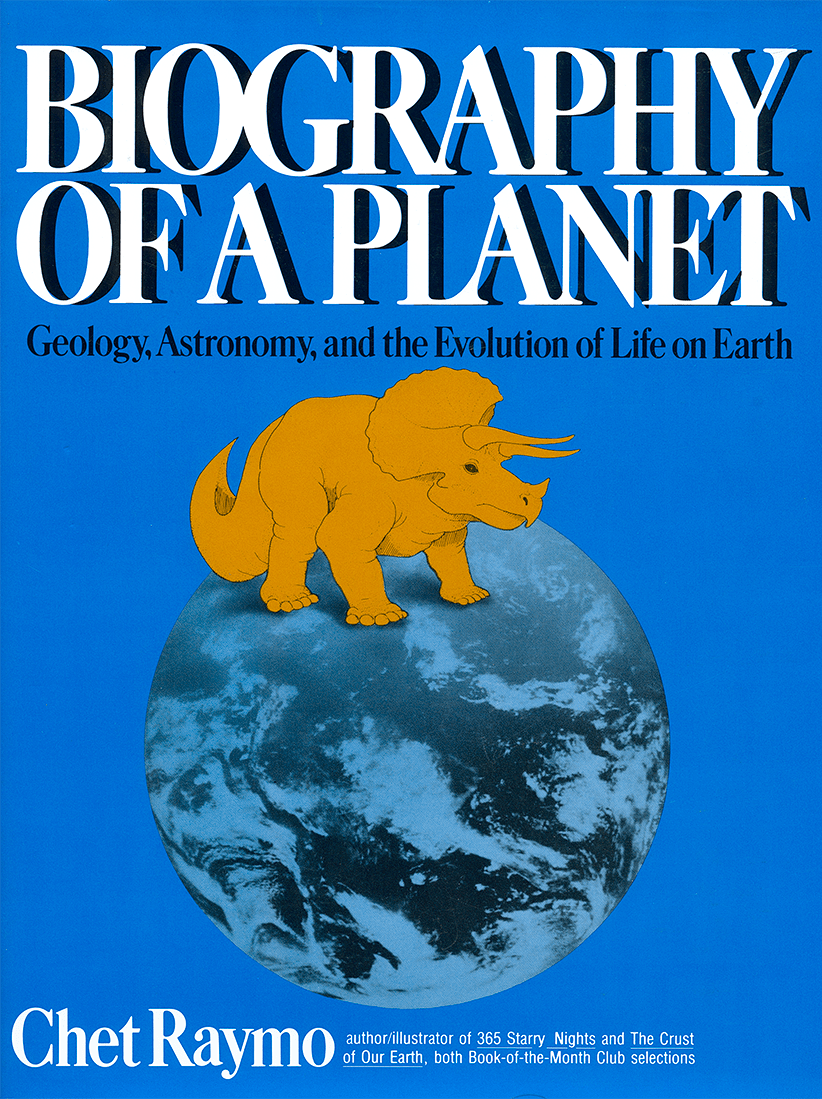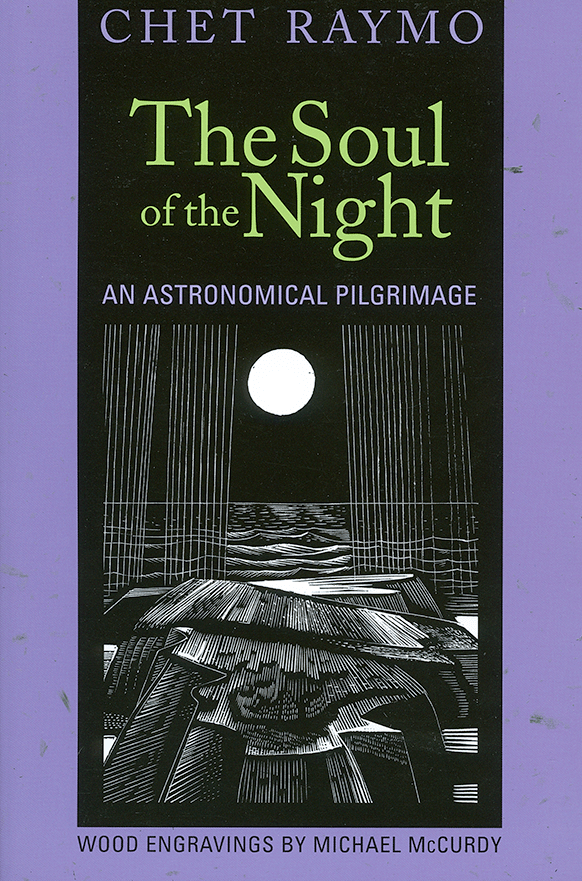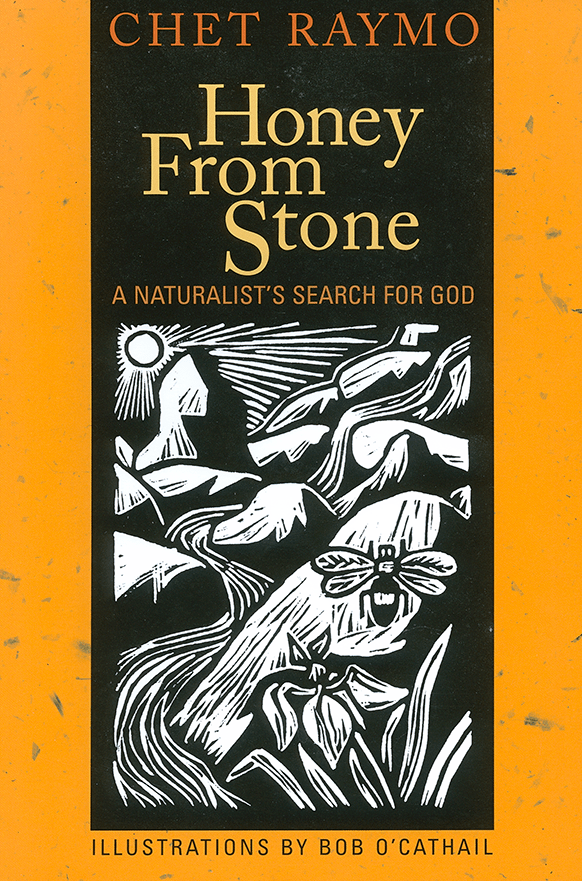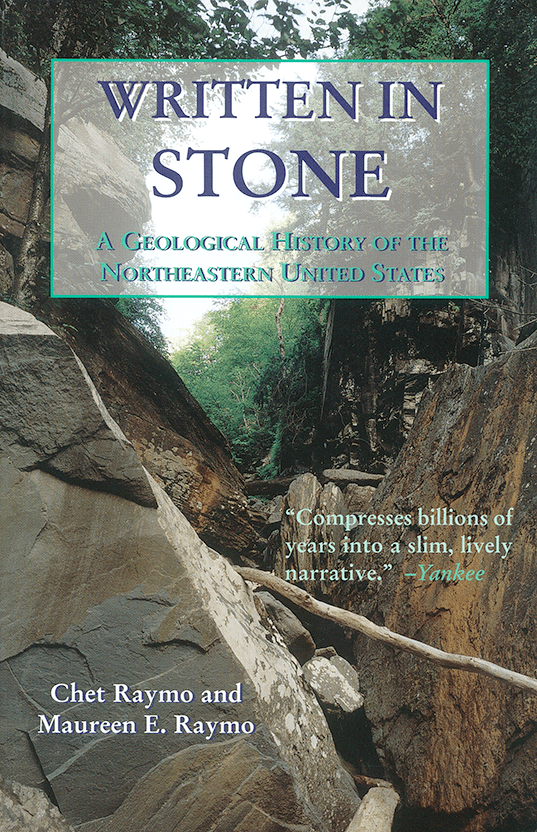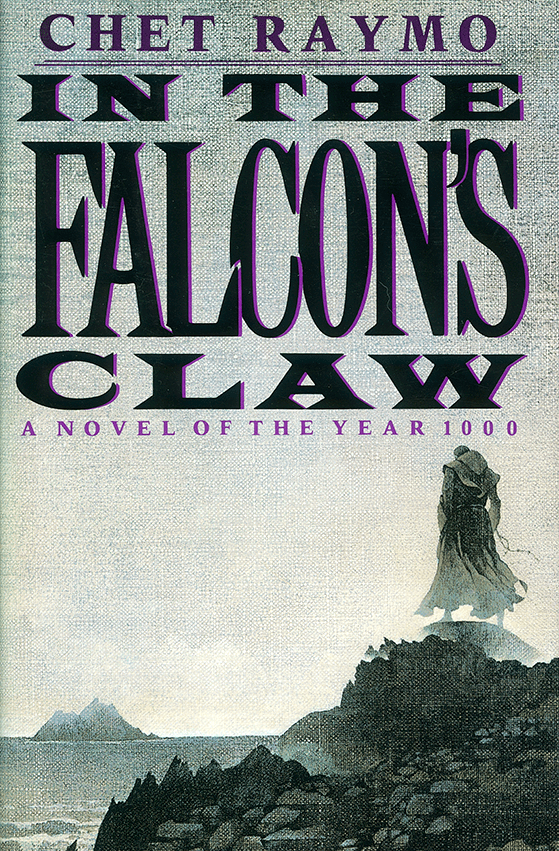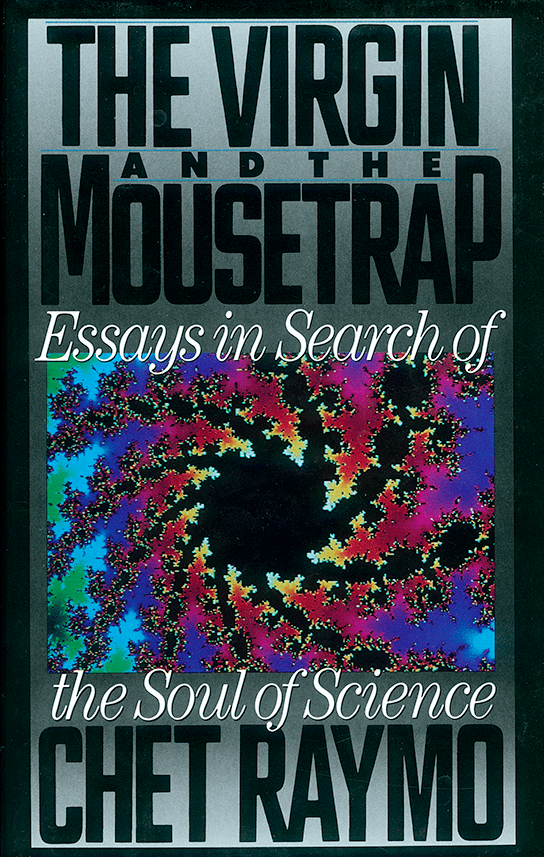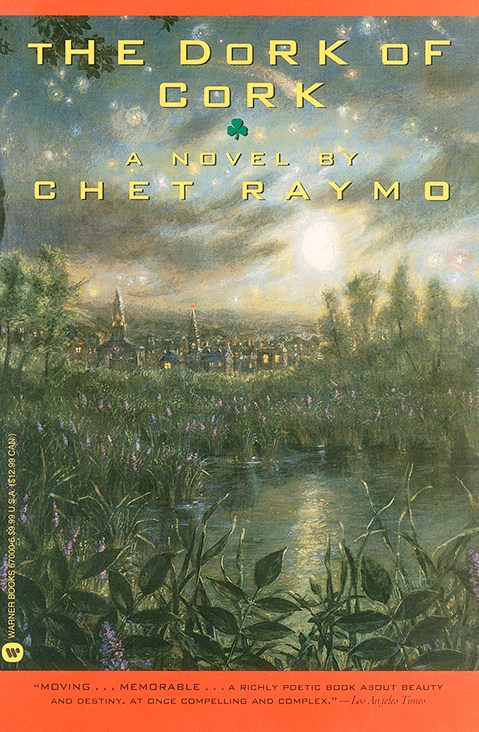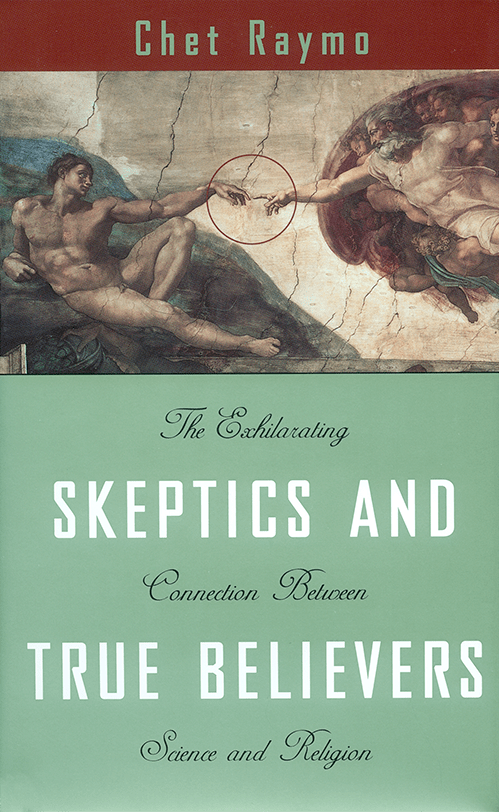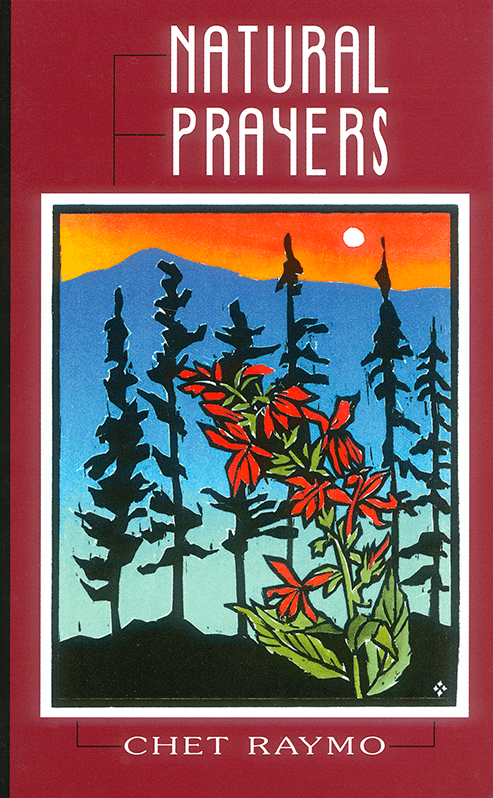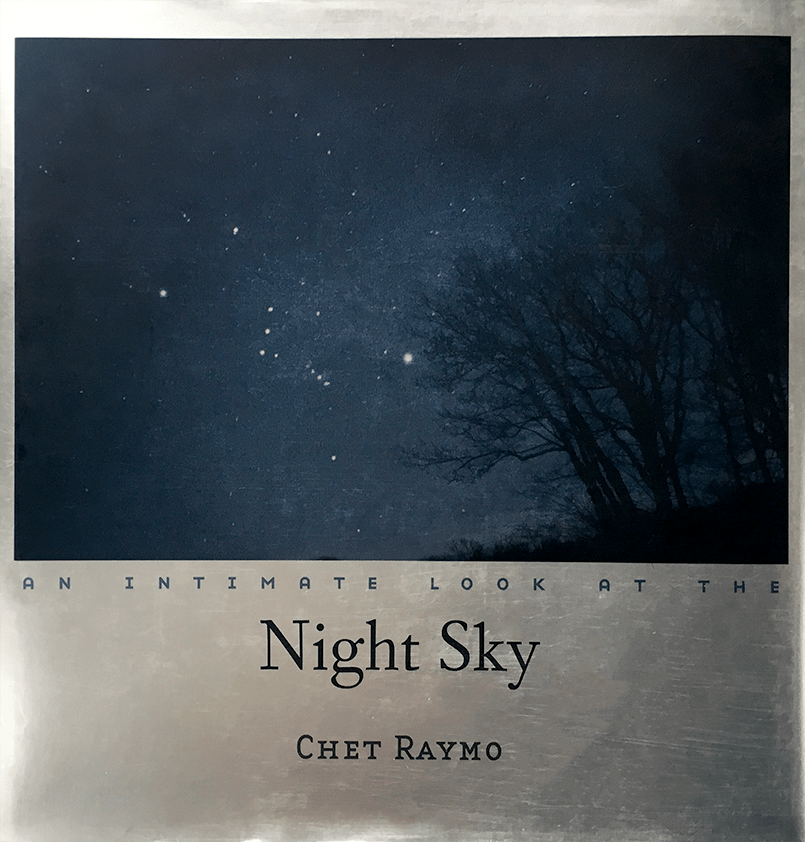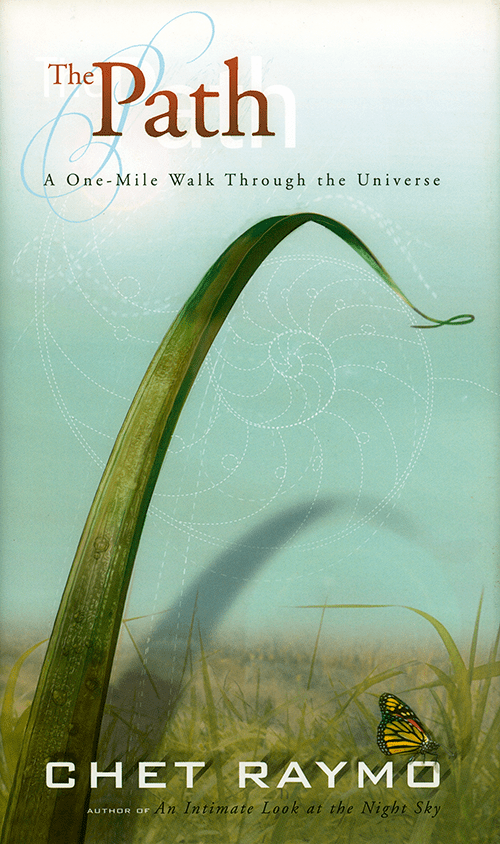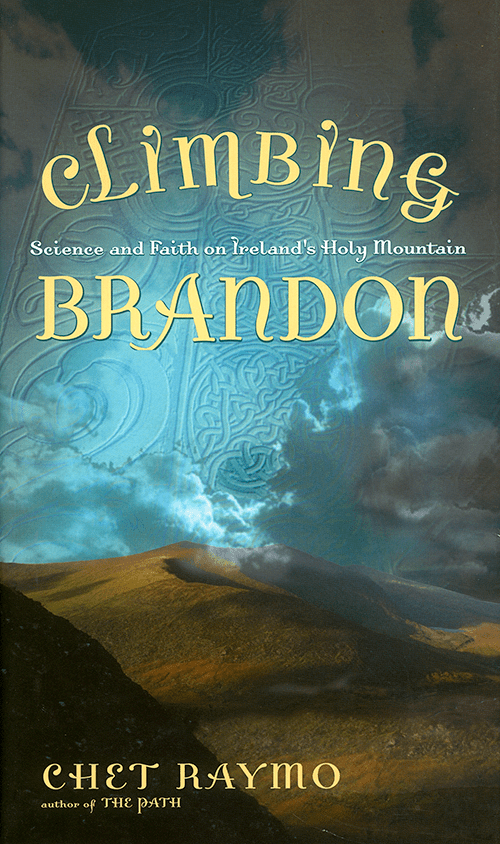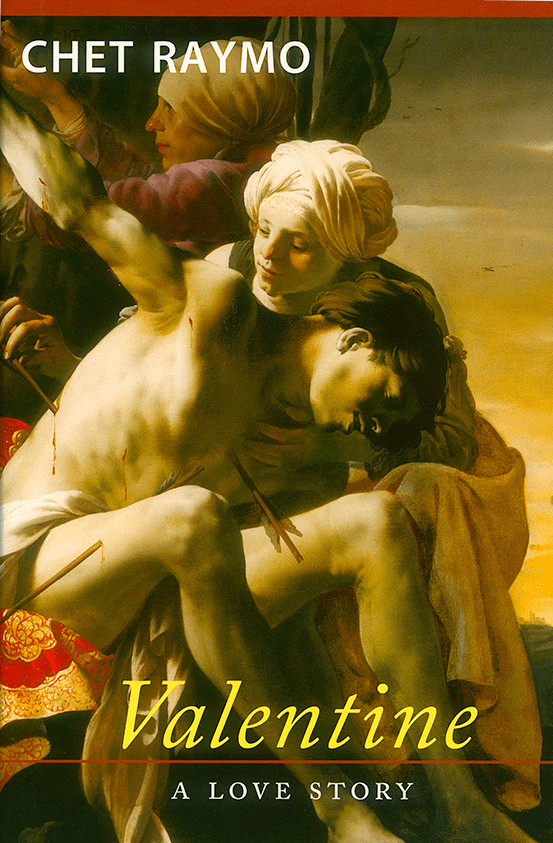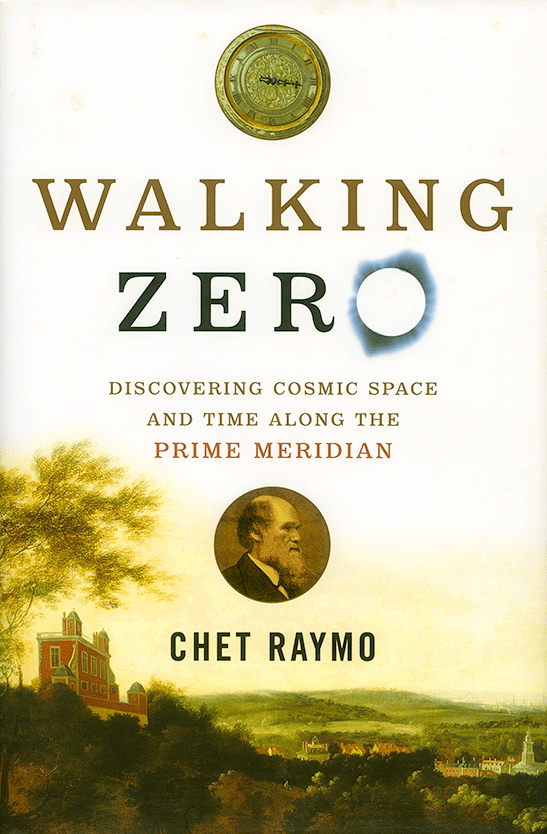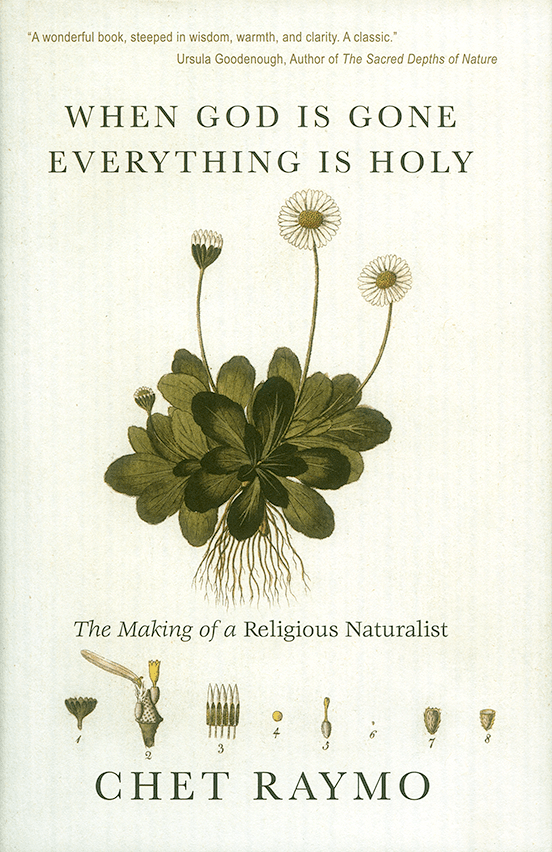Chet Raymo
Writer, Educator, NaturalistAbout Chet Raymo
Chet Raymo is Professor Emeritus at Stonehill College in North Easton, Massachusetts. He is the author of fourteen books on science and nature. His work has been widely anthologized, including in the Norton Book of Nature Writing. He is a winner of a 1998 Lannan Literary Award for his nonfiction work, and the subject of a biographical essay in American Nature Writers. Raymo has authored several novels including The Dork of Cork, which was made into a major film (Frankie Starlight). For twenty years he was a science columnist for the Boston Globe.
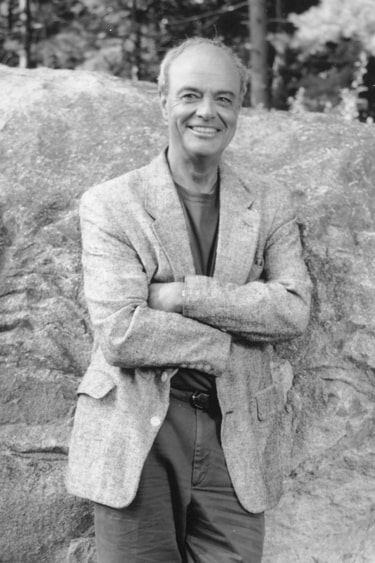
Books by Chet Raymo
365 Starry Nights
An Introduction to Astronomy for Every Night of the Year
Written and Illustrated by Chet Raymo
Originally published 1982
365 Starry Nights is a unique and fascinating introduction to astronomy designed to give you a complete, clear picture of the sky every night of the year.
Divided into 365 concise, illustrated essays, it focuses on the aesthetic as well as the scientific aspects of stargazing. It offers hundreds of charts, drawings, and maps that take you beyond the visible canopy of stars and constellations into the unseen realm of nebulae and galaxies.
This simple yet substantial text is full of critical information and helpful hints on how to observe the stars; describe their positions; calculate their age, brightness, and distance; and much more. Whether you observe the sky with a telescope or the naked eye, 365 Starry Nights makes the infinite intimate and brings the heavens within your grasp. Keep this invaluable, informative guide close at hand, and you’ll find that the sky is the limit 365 nights a year.
The Crust of Our Earth
An Armchair Traveler’s Guide to the New Geology
Written and Illustrated by Chet Raymo
Originally published 1983
With the advent of new theories in continental drift and plate tectonics, the study and exploration of geology has never been more exciting.
Through a combined visual and verbal presentation of the subject matter, Chet Raymo unravels phenomena that have long been cloaked in mystery. Sit back in your favorite easy chair and travel with jim to 60 familiar geological sites—from the exotic hot water vent communities of life on the floor of the Pacific to the glistening frozen ice cap of Antarctica.
Chet Raymo covers an enormous amount of useful information, treating each issue in exceptionally precise, nontechnical detail. With astonishing clarity, he makes the pieces of the geological puzzle fall into place, bringing out the beauty and excitement of the new geology in a way that captures your interest from the very first page.
Biography of a Planet
Geology, Astronomy, and the Evolution of Life on Earth
Written and Illustrated by Chet Raymo
Originally published 1984
In this handsomely illustrated volume, Chet Raymo takes you on a wonderous journey across 4 billion years of life on Earth.
Through precise and beautiful drawings, you’ll watch mouintains rise and fall, walk beneath continent-spanning walls of ice, and consider the fate of the dinosaurs.
Raymo traces the evolution of life on earth from its stardust beginnings to man’s flight back to the stars. In both verbal and visual essays, he captures the physical history of Earth and makes scientific concepts readily accessible to readers of all ages.
It is a book that both entertains and educates—a layperson’s guide to our planet in all its diversity.
The Soul of the Night
An Astronomical Pilgrimage
Written by Chet Raymo
Wood Engravings by Michael McCurdy
Originally published 1985
Chet Raymo’s elegant essays link the mysterious phenomena of the night sky with the human mind and spirit, as he ranges through the realms of mythology, literature, religion, history, and anthropology.
Originally published three decades ago, The Soul of the Night is a classic work that is a must for those interested in the relationship between science and faith.
“Chet Raymo’s book is for anyone who loves the music of words, the melodies of physics and the lyrics of a far-ranging and ingenious mind. Chet Raymo is one of my favorite writers for his wealth of imagery and the sheer pleasure of the writing.”
“Master taleteller, deft and graceful scientist, passionate poet, Raymo is a storycatcher and storysinger of rare humor, hawkness of eye, breadth of biology and physics acumen, and lyricism of line. Trust me when I say that swimming in his stories is elevating, edifying, and exuberant-making.”
Honey from Stone
A Naturalist’s Search for God
Written by Chet Raymo
Illustrations by Bob O’Cathail
Originally published 1987
What is the relevance of traditional religion in a world described by contemporary science? Is scientific knowledge a satisfactory ground for religious experience? Can the language of traditional religion constitute an appropriately modern language of praise?
In the framework of the medieval Book of Hours, the author’s thoughts and meditations on nature, science, and religion seek to answer these questions. The landscape of the Dingle Peninsula in the west of Ireland, where Chet Raymo has spent a good part of his life, triggered these reflections on the natural world, the significance of science, and the spiritual conundrums facing modern humankind. Noted Irish artist Bob O’Cathail’s linocuts emphatically and lyrically echo the author’s words.
“Chet Raymo, bless him, is one of those enchanting polymaths who are in love with the universe and use the language of science to make up the words for their love songs. So struck is he by the animated magnificence of clouds, hills, oceans, islands and the light in the sky that he makes geology, physics and astronomy into life sciences and then sings in the language of these life sciences to life itself.”
“A beautiful series of essays that examine science, religion, and the landscape of Kerry. . . . A travel book about the world of ideas.”
Written in Stone
A Geological History of the Northeastern United States
Written by Chet Raymo & Maureen E. Raymo
Originally published 1989
In vivid, nontechnical prose, Written in Stone traces the geologic changes in the Northeast since North America perched on the equator and dinosaurs were young. Grand events unfold as continents collide, oceans disappear, mountain ranges rise and fall, and mass extinctions decimate entire species.
The story, written in stone, translates the slow motion of geologic time into a gripping account of the forces that shaped our familiar landscape from Maine to New Jersey. This tale will inform and fascinate all who enter its realm.
“Hard to put down ... truly an adventure.”
“Will captivate the interested layperson and refresh the professional.”
In the Falcon’s Claw
A Novel of the Year 1000
Written by Chet Raymo
Originally published 1990
It is the year 998 A.D., two years before what much of Christian Europe believes will be the year of the Apocalypse. Strengthened by the devotion of a fearful and superstitious populace, the Church is seeking to harness a decaying Holy Roman Empire by asserting its absolute authority in interpreting the will of God.
So Aileran, abbot of a now-abandoned island monastery off the coast of Ireland, a man once believed to be a saint, is called to account for heresy. His accuser is his best friend, Gerbert, the charismatic fellow monk who first introduced Aileran to literature and geometry, to the pleasures of the flesh and perhaps to sin; Gerbert, now known as Pope Sylvester II.
Alone in self-exile, racked with pride, guilt and despair, Aileran struggles to make sense of the events that have led him to this pass. He recalls his idyllic childhood, which ended in violence; his education and adventures in the most renowned monasteries and courts of the age; and above all, his passionate and troubled relationship with the woman Melisande, who changed everything.
Eventually Aileran will have to come off his beautiful and desolate island to stand trial and to confront Gerbert and the woman he failed in love. But before the year 1000 dawns, one heretic at least will have to die.
Based on real events, places and people, In the Falcon’s Claw is a magical evocation of the political and pastoral landscapes of tenth-century Europe and a resonant tale of love and friendship. In the startlingly beautiful prose which has long distinguished his nonfiction books, Chet Raymo brings the distant past to life while exploring ageless questions of faith and spirit.
The Virgin and the Mousetrap
Essays in Search of the Soul of Science
Written by Chet Raymo
Originally published 1991
The lessons of contemporary science are not immediately reassuring: we are not the lords and purpose of creation; we are ordinary, perhaps even typical, fragments of a universe vast beyond our reckoning; nature is indifferent to our concerns. Faced with these disconcerting truths, which contradict traditional beliefs, many people turn from science with distrust or downright hostility. Often, they look instead to creationism, astrology, parapsychology, and other pseudosciences for a sense of meaning and worth.
Science can be remote, frightening, incomphrehensible. It is also a sublime attempt by the human mind to make sense of the world, and its discoveries have made life richer and more secure for much of the world’s population. The Virgin and the Mousetrap addresses our fears about science, and weighs the gifts of scientific knowledge against their costs. In his search for the soul of science—and for our own sense of place in the universe described by science—Raymo explores such topics as environmental responsibility, the use of animals in research, and technology in the service of national defense.
These essays draw upon literature, art, history, and philosophy to forge a reconciliation between scientific and humanistic concerns. If science is a mirror to creation, then it is also a mirror to ourselves. In The Virgin and the Mousetrap, Raymo looks into the mirror of science for life-affirming reflections of the human spirit.
The Dork of Cork
A Novel
Written by Chet Raymo
Originally published 1993
Frank Bois is 43 years old and 43 inches tall. But his yearnings are as wide and deep as the night sky he contemplates from his rooftop in Cork, Ireland. Having lived until now in anonymity, he has just written a memoir that will become an overnight literary sensation.
Yet fame will not be able to shield him from the past: his mother’s tragic childhood in Nazi-occupied France, her erotic, destructive relationships with the three men who loved her, and Frank’s own enduring passion for a woman he believes is as unreachable as the Milky Way.
All of it will be part of the great adventure that awaits him in both the outside world and the universe within ... all of it surrounded by the green, misty essence of Ireland, a place where miracles do happen.
“Touching ... luminous ... a powerful revelation of a tortured soul’s discovery of what beauty means ... quirky honesty, humor, and often such tasty writing that you are caught unawares.”
“Triumphs as an incandescent, big-hearted yarn.”
“Masterful ... classic ... what it really is is literature.”
Skeptics and True Believers
The Exhilarating Connection Between Science and Religion
Written by Chet Raymo
Originally published 1998
Years ago, noted science teacher and writer Chet Raymo embarked upon his own quest to reconcile the miracle stories he learned as a child with the science he learned as an adult. Skeptics and True Believers is the culmination of that search—a passionate, ever-inquisitive statement that science and religion can mutually reinforce the way we experience the world.
Acknowledging that the scientific and the spiritual communities are increasingly split, Raymo builds strong bridges between them. He illustrates his argument with an array of thought-provoking stories, such as the remarkable migratory flight of a small bird called the red knot; the long, glorious glide of the Comet Hyakutake across the night sky; a hilarious alien abduction that didn’t happen. Together, they are compelling evidence that religion should embrace the reliable knowledge of the world that science provides, while at the same time science should respect and nourish humankind’s need for spiritual sustenance. “Miracles are explainable,” Raymo paraphrases the writer Tim Robinson, “it is the explanations that are miraculous.”
For anyone drawn to reflect on life’s meaning and purpose, Chet Raymo’s uncompromising skepticism and reverence for mystery will affirm and inspire.
“Chet Raymo speaks with a voice of sanity that captures wonder; he is one of the best informed and wisest scientists writing for the general public today. He is also a humanistic thinker of the first rank and an inspiring optimist. I hope this book will help bring hum to the attention of the very wide readership he deserves.”
“These confessions of a wise religious humanist who also loves, practices, understands, and lives by the ideals and findings of science show us how to heal the false and unnecessary rifts in our intellectual cultures, and to bridge the gap between knowledge and morality.”
“Contemporary science has provided us with a new and fascinating creation story. But how does it square with the Book of Genesis and traditional religious faith? This is one question that Raymo takes up in this dazzling book on the current debate between science and religion. Raymo is a witty and clear-headed guide through the thickets of current science—from evolutionary biology to the miracles of DNA codes and theories of the Big Bang. At the same time he is a sensitive interpreter of authentic relgious faith and its compatibility with the scientific search.”
Natural Prayers
Written by Chet Raymo
Originally published 1999
Informed by his work as a physicist and astronomer, Raymo strives to connect with that which unifies our intricate world, and thus effectively explores the wonders of what Nikos Kazantzakis called “the dread essence beyond logic.” The “natural prayers” that flow from the pages of Raymo’s work, then, begin as mere observations of his surroundings in the Bahamas, New England, and Ireland, and slowly open into profound meditations immersed in the languages of science and literature.
“To the end, Raymo offers a beautiful breviary of his moments of deep attention to the natural world, set in three different landscapes, following the moon cycles of the year.”
“Physicist Chet Raymo chews up the Big Bang Theory and spits out something that Blake might have written about angels. Spend an evening stargazing with this man and you’ll never be the same.”
“Raymo’s writing is passionate and compassionate, mixing his reverence for the myriad possibilities of life with his amazement at what science has revealed.”
An Intimate Look at the Night Sky
Written by Chet Raymo
Originally published 2001
“We are children of the night,” proclaims Chet Raymo in this rich, exciting guide to the universe. Not so very long ago, the night sky was an intimate part of people’s lives, often a source of religious and poetic inspiration. Gradually, though, the glare of city lights, a fast-paced lifestyle, and “prime-time” television have eroded that intimacy. This book offers you the chance to recapture a personal connection to the heavens, enlarging your concept and appreciation of the universe rather than feeling diminished by its scale.
On one level, An Intimate Look at the Night Sky is a unique star guide: twenty-four beautiful star maps, created specifically for this book, cycle through the seasons and across the heavens, revealing what you can see with the naked eye throughout the year on a clear night in the northern hemisphere. Raymo’s commentaries amplify the maps, offering intriguing details and tips on identifying stars, planets, and constellations.
On another level, Chet Raymo challenges our imagination—to see what is unseeable in the universe, to perceive distance and size and shape that is inconceivable, to appreciate ever more fully our extraordinary place in the cosmos. His elegant essays on the heavens blend science and history, mythology and religion, making clear why he is one of the most insightful and passionate science writers of our time.
After reading An Intimate Look at the Night Sky, which is as visually appealing as it is intellectually stimulating, you will marvel as much at the wisdom of the ancients as at the advances of modern science. Chet Raymo’s artistry enables us to see the universe we inhabit through new eyes.
The Path
A One-Mile Walk Through the Universe
Written by Chet Raymo
Originally published 2003
For nearly forty years, Chet Raymo has walked a one-mile path from his house in North Easton, Massachusetts, to the Stonehill College campus where he has taught physics and astronomy. The woods, meadows, and stream he passes are as familiar to him as his own backyard, yet each day he finds something new. “Every pebble and wildflower has a story to tell,” Raymo says.
In The Path, Raymo chronicles the universe he has found by closely observing every detail of his route. He connects the local to the global, the microscopic to the galactic, with a scientists’s curiosity, a historian’s respect for the past, a child’s capacity for wonder. With each step, the landscape he traverses becomes richer and more multidimensional, opening door after door into astromnomy, geology, biology, history, and literaure.
“The flake of granite in the path was once at the core of towering mountains pushed up across New England when continents collided,” he writes. “The purple loosestrife beside the stream emigrated from Europe in the 1800s as a garden ornamental, then went wantonly native in a land of wild frontiers. The light from the star Arcturus I see reflected in the brook beneath the bridge at night has been traveling across space for forty years before entering my eye. I have attended to all of these stories and tried to hear what the landscape has to say .... I have attended, too, to language. How did the wood anemone and Sheep Pasture get their names? What does the queset of Queset Brook signify in the language of Native Americans? Scratch a name in a landscape, and history bubbles up like a spring.”
The path also reveals the stories of nineteenth-century industrialists who transformed natural resources into power, and turn-of-the-century landscape architects, such as Frederick Law Olmsted, who championed an ideal of nature tamed by conscious intent. In its transformations over the centuries, Raymo writes, the path “encapsulates in many surprising ways the history of our nation and of our fickle love affair with the natural world.”
Recognizing that his path is commonplace, and that we all have such routes in our lives, Raymo urges us to walk attentively, stopping often to watch and listen with care. His wisdom and insights inspire us to turn local paths—whether through cities, suburbs, or rural areas—into doorways to greater understanding of nature and history.
“What better guide could there be to the wonders of this world than a man versed in history and science, a man fond of tramping throug the countryside in all seasons, a man blessed with a poet’s eye and a tale-teller’s tongue? It’s a delight to journey anywhere with Chet Raymo, who sees supernovas in a drop of dew, infinity in a grain of sand. Follow him down his neighborhood path, and you’ll be reminded that every moment of this life, every spot of this Earth, is miraculous.”
“As a scientist, Chet Raymo has a mature love affair with the universe and shares it with us through eloquent discourse, ranging from black holes to bluebirds. He writes that ‘The arrow of history was shot from nature’s bow 15 billion years ago and won’t be put back.’ Raymo himself shoots literary arrows that often travel in a beautiful unerring arc from the local to the universal. Whether the subject is human nature, rivers, or stars, The Path conveys a love of nature that combines the insights of science with joyous writing.”
“A little masterpiece.”
Climbing Brandon
Science and Faith on Ireland’s Holy Mountain
Written by Chet Raymo
Originally published 2004
An acclaimed science writer celebrates an enduring symbol of Ireland’s Celtic past, Christian tradition, and love of nature.
Mount Brandon is one of several holy mountains in Ireland that attract scores of believers and secular trekkers from around the world. For thirty-two years, Chet Raymo has lived part of each year on the Dingle Peninsula, near the foot of the mountain, and he has climbed it perhaps a hundred times, exploring paths that have been used for centuries by pilgrims in search of spiritual enlightenment. But the history and geography of Mount Brandon are what drew Raymo to it and offered him a lens through which to view the modern conflicts between science and religion.
As he guides us up the mountain, Raymo weaves folklore and natural history, spiritual and physical geographies. He tells the stories of the pagan hero Bran and the Christian saint Brendan, whose name the mountain evokes. He also teases out the scientific story of the mountain and its environs—spinning planet, drifting continents, grinding glaciers, globe-spanning ocean currents, animal and plant migrations—and discovers to his surprise and delight how well our new empirical knowledge of the world is accomodated by the faith of the earliest Irish Christians.
When Ireland converted from paganism, it became home to a kind of Christianity that was unique in Europe—intensely intellectual yet attuned to nature, skeptical yet celebratory, grounded in the here-and-now yet open to infinity—a faith that did not so much look upward to the heavens as westward into the wild dark sea. Raymo takes us to a time on the wave-lashed edge of the Western world when Mediterranean Christianity ran up against Celtic nature worship, and the Irish, for a few exhilarating centuries, forged a fusion of knowledge and mystery that has special relevance for us today.
“Vivid descriptive prose...an uplifting contemplation of the power of landscape.”
“[An] intriguing journey into faith, Irish culture, and the world of science.”
“A splendid book.”
Valentine
A Love Story
Written by Chet Raymo
Originally published 2006
Very little is known about the man who gave his name to romantic love, but bestselling novelist Chet Raymo has imagined Valentine’s life and brought it vividly to the printed page.
There has long been a suggestion that Valentine was a doctor, and Raymo has built his story around the romance of the physician Valentine and the blind Julia, daughter of a Roman jailer. Their love story provides the central thread of this engrossing novel, which also brings alive the world of the Roman Empire during the reign of Claudius II—a time of clashing and evolving worldviews, in which Christianity was on the rise while Christians were still among those whose deaths provided public entertainment at the Circus Maximus.
Valentine is a novel with remarkable resonances, its ideas startlingly relevant to our own times: globalization vs. fundamentalism, reason vs. superstition, the subversion of virtue by wealth—and the power of passionate love to overcome all obstacles to its consummation.
Walking Zero
Discovering Cosmic Space and Time Along the Prime Meridian
Written by Chet Raymo
Originally published 2006
In Walking Zero, Chet Raymo uses the Prime Meridian—the line of zero longitude and the standard for all the world’s maps and clocks—to tell the story of humandkind’s intellectual journey from a cosmos not much larger than ourselves to the universe of the galaxies and geologic eons.
As in his highly praised The Path and Climbing Brandon, Raymo connects personally with the story by walking England’s Prime Meridian from Brighton through Greenwich to the North Sea. The Prime Meridian passes near a surprising number of landmarks that loom large in science: Isaac Newton’s chambers at Trinity College, Cambridge; Charles Darwin’s home at Down, in Kent; the site where the first dinosaur fossils were discovered; and John Harrison’s clocks in a museum room of the Royal Observatory, among many others. Visiting them in turn, Raymo brings to life the human dramas of courageous individuals who bucked reigning orthodoxies to expand our horizons, including one brave rebel who paid the ultimate price for surmising the multitude of worlds we now take for granted.
A splendid short history of astronomy and geology, Walking Zero illuminates the startling interplay of science, psychology, faith, and the arts in our understanding of space and time.
“The story of the prime meridian is in itself fascinating: in 1884 an international agreement fixed a meridian of zero longitude and standard time through southeast England. But Raymo, a physicist and science writer who wrote a popular weekly column for the Boston Globe, goes beyond this tale. He uses an actual walk along the meridian as a ‘thread on which to hang’ a history of astronomy, geology and paleontology. Stops at sites near the meridian include Newtons rooms at Cambridge, Darwins house at Down, the infamous town of Piltdown, and the place where the first dinosaur fossils were discovered. A walk with this delightful writer is the best exercise a reader could have.”
When God is Gone Everything is Holy
The Making of a Religious Naturalist
Written by Chet Raymo
Originally published 2008
Chet Raymo steps into the fray between science and religion and seeks to delineate a new perspective, forged from both the rigorous standards of the academy and the reverence for creation born of the Catholic sacramental tradition. As a scientist, Raymo holds to the skepticism that accepts only verifiable answers and replies to life’s ultimate questions with the agnostic response, “I don’t know.” But as a “religious naturalist,” he never ceases his pursuit of “the beautiful and terrible mystery that soaks creation, diminished by any name we give it. Faith no longer matters to me,” he says, “so much as attention, celebration, wonder, and praise.”
In what he describes as a “late-life credo,” Raymo traces a half-century journey from traditional faith-based Catholicism to scientific agnosticism. The point of religion, he asserts, is to celebrate the unfathomable mystery of creation. Thus, he believes, “My work as a teacher and writer has been to discover glimmers of the Absolute in every particular, and praise what I find.”
Raymo takes the reader on a tour de force of science, philosophy, theology, and literature as he gathers together the rich array of voices of his many traveling companions. With wonderfully detailed anecdotes, Raymo brings to life a diverse cadre of mentors such as Gerard Manley Hopkins, Charles Darwin, and Teilhard de Chardin. Whether exploring the connection of the human body to the stars or the meaning of prayer of the heart, these challenging reflections will cause believers and agnostics alike to pause and pay attention.
“Chet Raymo has enriched and graced our lives with this wonderful book, steeped in wisdom, warmth, and clarity. A classic.”
“Piercing, funny, brilliant, transcendent, angry, eloquent. One of the nation’s finest naturalists and writers pours out his heart on the roaring prayer of Everything That Is adn the idiocy of arguing over labels and possession of that which is beyond our ken but not our celebration and singing, which is what Raymo does with stunning power and passion.”
“This is a magnificent book, but not one for the faint of heart. In an age of militant atheists and strident believers, Chet Raymo dares to stand, where mystics and philosophers have always stood, in the place of mystery.”
Chattanooga
A Novel
Written by Chet Raymo & Dan Raymo
Originally published 2011
Set against the backdrop of World War II and growing racial tension in Tennessee, Chattanooga finds Mamie Buffon, her seven daughters, two son-in-laws, granddaughter, bed-ridden brother, and two black housekeepers packed together in a highly dysfunctional household fraught with marital, sexual and racial tension. None of them could possibly imagine what the summer of 1944 had in store for them as the novel hurtles towards its dramatic conclusion.
Science Musings
Chet Raymo’s weekly Science Musings column appeared in the Boston Globe from 1983 to 2003. The column offered informed and provocative meditations on science as a creative human activity and celebrated the grandeur and mystery of the natural world.
Chet continued writing Science Musings online at ScienceMusings.com from 2004 until his retirement from writing in 2016. In thirty years, both in print and online, he produced over one thousand essays and four thousand blog posts exploring science and nature.
A comprehensive Science Musings archive was launched in 2019.
